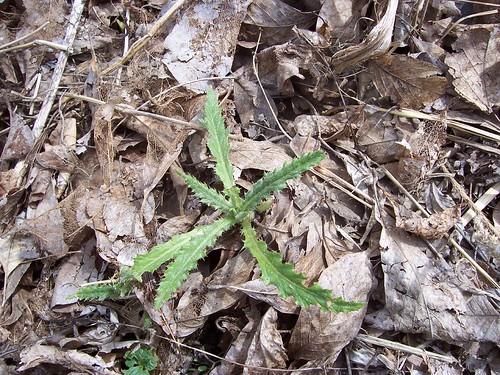Cleveland Weeds – Canada Thistle
This is a post that relates to the Cleveland Weeds project.
In this post I am going to cover Canada Thistle
Spring
Click on image or here to enlarge
SummerComing Soon
FallComing Soon
Latin Name: Cirsium arvens
Common Names: Canada thistle, Creeping Thistle, Californian Thistle, Field Thistle, Corn Thistle
Lifespan: Perennial
Conditions it likes: This weed grows best in recently disturbed (i.e. tilled or dug) soil. It can grow in any type of soil, including high salt content dirt.
Spreading habits: Spreads by seeds or creeping root system.
Best way to eliminate it from your garden:
Organic: The first thing to remember is do not pull this weed out of the ground. The roots are designed to break and split when pulled, so wherever you pull out one, two will grow later.
One way to combat Canada Thistle is to plant the area with competitive plants, such as grass and alfalfa. But, while this method will reduce the amount of Canada Thistle, it may not completely eliminate it.
Another way is to vigorously pinch or snip the plant as new growth appears (about every 10 days) until the plant dies due to lack of sunlight and the food made by the leaves. Black plastic covering an infected area will work too as will razing or controlled burning the area repeatedly. Any of these methods may take several months or years to completely control the infestation.
Boiling water may also be used to try to eliminate the plant but the entire root system must be treated with the boiling water. Please note that boiling water will kill any vegetation that it comes in contact with so this method should not be used if the Canada Thistle has infested an area that already contains plants you want to keep.
Non-Organic: Canada Thistle is resistant to many types of herbicides, including all or nothing herbicides such as RoundUp. You will most likely need to do several applications of herbicide before the infestation is completely taken care of. It is recommended that you use organic methods (listed above) to weaken the Canada Thistle before applying herbicide. The herbicide will work much more effectively on a weakened plant. Canada Thistle is also susceptible to overwatering. Too much water will weaken the Canada Thistle temporarily. Try applying herbicide after a heavy rainfall or after purposely overwatering the area the Canada Thistle has infested. Start weed control in the early spring and repeat until the infestation is gone.
Notes of interest: Canada Thistle produces a chemical that will inhibit the growth of other plants, even other Canada Thistles. Canada Thistle is also a food source for the engrailed moth. Grazing animals will not eat anywhere near where Canada Thistle grows, so if you own horses or cows, a bad infestation of Canada Thistle in your pastures can cause problems. Canada Thistle is not from Canada. It actually came from Europe.
This gardener’s rating of this weed: Cockroach of the plant world. I think if nuclear holocaust were to happen, Canada Thistle would make it through without batting a leaf.

Pingback: What I Hate About My Garden